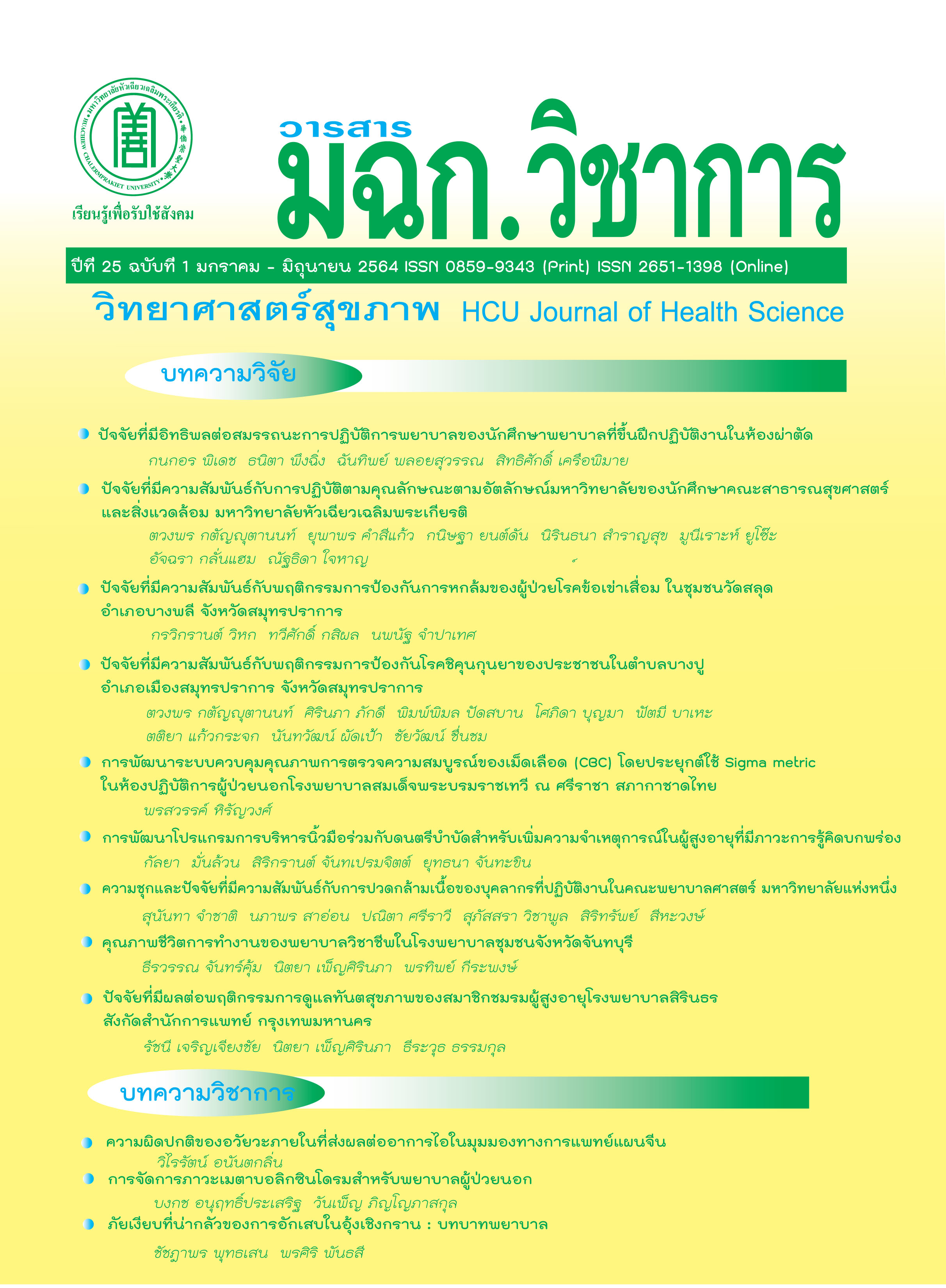Factors Influencing Postoperative Hemorrhage in Open-heart Surgery Patients
Keywords:
Postoperative hemorrhage in open-heart surgery, open heart surgery, open heart surgery patientsAbstract
The objective of this descriptive study was to determine the factors influencing postoperative hemorrhage following open heart surgery in 245 patients who had undergone open heart surgery in a private hospital in 2015-2016. Retrospective study was conducted by collecting medical records of patients who had undergone open heart surgery and were over 18 years of age. The data obtained were analyzed with descriptive statistics, chi-square, Fisher’s exact test and binary logistic regression analysis.
According to the findings, the variables correlated with postoperative hemorrhage in open heart surgery patients included diabetes mellitus disease, left ventricle ejection fraction and the activated clotting time (ACT). There were two factors influencing postoperative hemorrhage following open heart surgery patients including left ventricle ejection fraction (AOR= 12.53, 95%CI = 1.35-116.58, p=0.03) and the activated clotting time postoperative (AOR= 7.17, 95%CI = 1.15-44.71, p=0.04) (Nagelkerke R2 = 0.34).
The research findings suggested that nurse and health care team should check-up and follow-up examination of left ventricle ejection fraction before open heart surgery and the activated clotting time postoperative. Furthermore, guidelines should be formed for monitoring and preventing severe hemorrhaging before and after open heart surgery.
Downloads
References
2. Kristensen, KL, Rauer, LJ, Mortensen, PE, & Kjeldsen, BJ. Reoperation for bleeding in cardiac surgery. Interactive cardiovascular and thoracic surgery. (2012); 14(6):709-713.
3. The society of thoracic Surgeons of Thailand. Statistic of heart surgery in Thailand 2001-present. (2560). 2017 January 30. Retrieve form http://thaists.org/news_detail.php?news_id=212
4. Kaseamrad Prachachuen Heart Center. Statistic of heart surgery 2015-1016. (2560).
5. Dyke, C, Aronson, S, Dietrich, W, Hofmann, A, Karkouti, K, Levi, M, et al. Universal definition of perioperative bleeding in adult cardiac surgery. The Journal of thoracic and cardiovascular surgery. (2014); 147(5):1458-1463.
6. Ranucci, M, Baryshnikova, E, Castelvecchio, S, & Pelissero, G. Major bleeding, transfusions, and anemia: the deadly triad of cardiac surgery. The Annals of thoracic surgery. (2013); 96(2):478-485.
7. Sornpirom, S. Critical Nursing care for post-op cardiovascular. Srinagarind Medical Journal. (2016); 31(5):46-52.
8. Hirunpiyopas, A. & Prachusilpa, K. Predicting factors of competency of professional nurses in coronary care unit. Thai Journal of Cardio-Thoracic Nursing. (2016); 27(2): 71-84.
9. Khamsiri N, Wanitkun N, Sindhu S, Bunburaphong P. The relationship between blood loss, systemic inflammatory response syndrome, blood glucose, pain, and recovery in patients during the first 12 hours after open heart surgery. Thai J Cardio Thorac Nurs 2012; 23(1):4-19.
10. Ozolina, A, Strike, E, Harlamovs, V, & Porite, N. Excessive bleeding after cardiac surgery in adults: Reasons and management. Acta chirurgica latviensis. (2009); 9(1):86-91.
11. Sahin, V., M. Kaplan, et al. The relation between blood and tissue magnesium levels and development of atrial fibrillation after coronary artery bypass surgery. Anadolu Kardiyol Derg. (2010); 10(5):446-451.
12. Pieri, M, Belletti, A, Monaco, F, Pisano, A, Musu, M, Dalessandro, V, et al. Outcome of cardiac surgery in patients with low preoperative ejection fraction. BMC anesthesiology. (2016); 16(1):97.
13. Pieri, M, Belletti, A, Monaco, F, Pisano, A, Musu, M, Dalessandro, V, et al. Outcome of cardiac surgery in patients with low preoperative ejection fraction. BMC anesthesiology. (2016); 16(1):97.
14. De Souza Magalhães Pereira, KMF, de Assis, CS, Lacerda Cintra, HNW, de Lucena Ferretti‐Rebustini, RE, Alves de Araújo Püschel, V, Santos, ES, et al. Factors associated with the increased bleeding in the postoperative period of cardiac surgery: a cohort study. Journal of clinical nursing. 2018; 2017 January 30. Retrieve from https://doi.org/10.1111/jocn.14670
15. Petrou, A, Tzimas, P, & Siminelakis, S. Massive bleeding in cardiac surgery. Definitions, predictors and challenges. Hippokratia. 2016; 20(3): 179-186.
16. Bove, T, Monaco, F, Covello, RD, & Zangrillo, A. Acute renal failure and cardiac surgery. HSR proceedings in intensive care & cardiovascular anesthesia. 2009; 1(3): 13.
17. Bench, S, & Brown, K. (Eds.). Critical Care Nursing: learning from practice. John Wiley & Sons; 2011.
18. Pumsaimoon, N. Risk Factors of Major Cardiovascular Complications during Surgery among Elderly Patients in Vachira Phuket Hospital. Region 11 Medical Journal. (2017); 31(4): 675-684
19. Vivacqua, A, Koch, CG, Yousuf, AM, Nowicki, ER, Houghtaling, PL, Blackstone, EH, et al. Morbidity of bleeding after cardiac surgery: is it blood transfusion, reoperation for bleeding, or both?. The Annals of thoracic surgery. (2011); 91(6):1780-1790.
20. Prapaitrakool, S, Kongsayreepong, S. Perioperative Blood Transfusion in Cardiac Surgery at Thammasat University Hospital: A retrospective review. Thai Journal of Anesthesiology. (2017); 40(1): 7-16.
21. Waiwaree, D, Sindhu, S, Utriyaprasit, K, Slisatkorn, W. Factors predicting functional status in patients coronary artery bypass graft. Thai Journal of Cardio-Thoracic Nursing. (2017); 28(2):126-139.
22. Prapaitrakool, S, Kongsayreepong, S. Perioperative Blood Transfusion in Cardiac Surgery at Thammasat University Hospital: A retrospective review. Thai Journal of Anesthesiology. (2017); 40(1): 7-16.
Downloads
Published
How to Cite
Issue
Section
License
บทความที่ได้รับการตีพิมพ์เป็นลิขสิทธิ์ของวารสารวิทยาศาสตร์สุขภาพและสุขภาวะ
ข้อความที่ปรากฏในบทความแต่ละเรื่องในวารสารวิชาการเล่มนี้เป็นความคิดเห็นส่วนตัวของผู้เขียนแต่ละท่านไม่เกี่ยวข้องกับมหาวิทยาลัยหัวเฉียวเฉลิมพระเกียรติ และคณาจารย์ท่านอื่นๆในมหาวิทยาลัยฯ แต่อย่างใด ความรับผิดชอบองค์ประกอบทั้งหมดของบทความแต่ละเรื่องเป็นของผู้เขียนแต่ละท่าน หากมีความผิดพลาดใดๆ ผู้เขียนแต่ละท่านจะรับผิดชอบบทความของตนเองแต่ผู้เดียว




